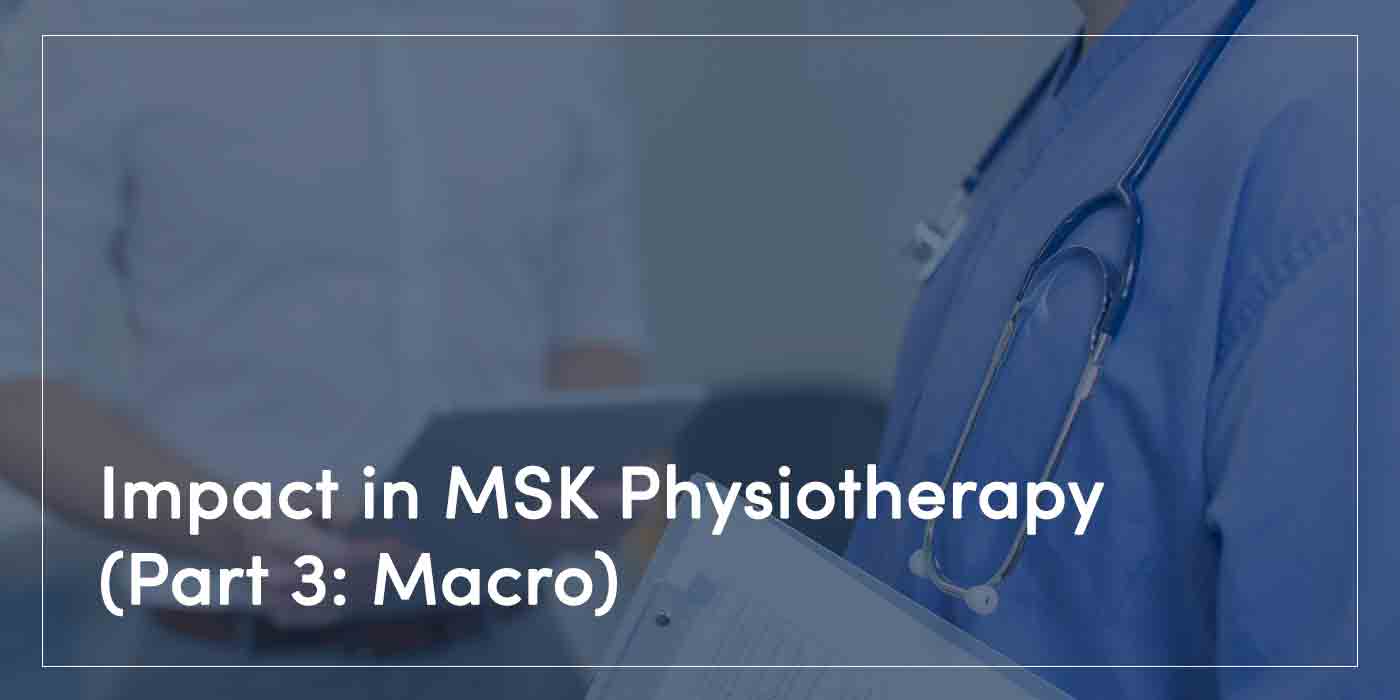Impact in MSK Physiotherapy – Part 3: Macro

In this final part of our short series on MSK physiotherapy impact, we look at the impact MSK physiotherapy may have within a population. Once again, this is no way exhaustive and reflects ongoing conversations with the team.
When considering MSK physiotherapy on a macro scale in terms of impact, the key factors for a population are of course broad, but perhaps wellness, physicality levels, engagement in activity, staying in work, would be some of the key deliverables for any healthcare provider.
So, the questions remain; does MSK physiotherapy impact in these big-ticket areas of population health, and also has it addressed any of the harder-to-reach populations that all healthcare professions need to consider?
Cited as important competencies for aiding patients’ return to work, St Georges et al 2022 concluded that there were three elements for clinicians to consider.
They were: 1) Understanding and interacting with patients who are workers; (2) Planning rehabilitation with other stakeholders, and (3) Reaching out to the workplace.
Psychological distress, anxiety and length of sickness are negative predictors for return to work. MSK physiotherapy wanting to impact in this space would need to ensure that practice and competency reflects this requirement (Brendbekken et al 2018).
Therefore, MSK physiotherapy wanting to impact at a population level would need to ensure clinicians are competent in the vocational and psychological elements of the supportive guidance approach.
Engaging patients to be more active would be a pre-requisite for making that contact count, but in long term conditions this is not always the case (Oliveira et al 2016), and interventions designed to increase activity may not impact at all. It is also suggested that physiotherapists may not always follow best practice guidelines when prescribing exercise for activity and wellness (Barton et al 2021).
However, counter views suggest that physiotherapy can positively influence physical activity levels (Holm et al 2015), and so as a profession MSK physiotherapy in the right context can offer those positive changes.
But importantly, can those positive impacts be achieved in groups where it is needed the most? Rehabilitation for these groups, whether workbased or activity-focused would need to be part of any stakeholder design for the future and be embedded in the community, with access key, and support multi-factorial.
So, in conclusion on our commentary regarding the micro, meso and macro impact that MSK physiotherapy can have, we wonder how we can improve our clinicians’ understanding of work disorders and return to work programmes; how clinicians can improve competence in this area; and how clinicians can support the psychological elements, as well as being proficient in improving the physical activity of all groups within the population.
References
Barton, C.J., King, M.G., Dascombe, B., Taylor, N.F., de Oliveira Silva, D., Holden, S., Goff, A.J., Takarangi, K. and Shields, N., 2021. Many physiotherapists lack preparedness to prescribe physical activity and exercise to people with musculoskeletal pain: a multi-national survey. Physical Therapy in Sport, 49, pp.98-105.
Brendbekken, R., Vaktskjold, A., Harris, A. and Tangen, T., 2018. Predictors of return-to-work in patients with chronic musculoskeletal pain: A randomized clinical trial. Journal of Rehabilitation Medicine, 50(2), pp.193-199.
Holm, I., Tveter, A.T., Moseng, T. and Dagfinrud, H., 2015. Does outpatient physical therapy with the aim of improving health-related physical fitness influence the level of physical activity in patients with long-term musculoskeletal conditions?. Physiotherapy, 101(3), pp.273-278.
St-Georges, M., Hutting, N. and Hudon, A., 2022. Competencies for Physiotherapists Working to Facilitate Rehabilitation, Work Participation and Return to Work for Workers with Musculoskeletal Disorders: A Scoping Review. Journal of Occupational Rehabilitation, 32(4), pp.637-651.
Oliveira, C.B., Franco, M.R., Maher, C.G., Christine Lin, C.W., Morelhão, P.K., Araújo, A.C., Negrão Filho, R.F. and Pinto, R.Z., 2016. Physical activity interventions for increasing objectively measured physical activity levels in patients with chronic musculoskeletal pain: a systematic review. Arthritis care & research, 68(12), pp.1832- 1842.